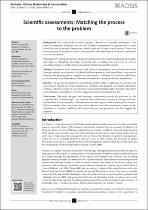JavaScript is disabled for your browser. Some features of this site may not work without it.
- ResearchSpace
- →
- Research Publications/Outputs
- →
- Journal Articles
- →
- View Item
| dc.contributor.author |
Scholes, RJ

|
|
| dc.contributor.author |
Schreiner, G

|
|
| dc.contributor.author |
Snyman-Van der Walt, L

|
|
| dc.date.accessioned | 2018-02-12T09:59:49Z | |
| dc.date.available | 2018-02-12T09:59:49Z | |
| dc.date.issued | 2017-01 | |
| dc.identifier.citation | Scholes, RJ, Schreiner, G and Snyman-Van der Walt, L. 2017. Scientific assessments: Matching the process to the problem. Bothalia - African Biodiversity & Conservation, v 40(2), 9pp. | en_US |
| dc.identifier.issn | 0006-8241 | |
| dc.identifier.uri | http://hdl.handle.net/10204/10036 | |
| dc.description | Copyright: 2017 AOSIS Publishing. This is an open access article. | en_US |
| dc.description.abstract | Background: The science–policy interface process – known as a ‘scientific assessment’ – has risen to prominence in the past few decades. Complex assessments are appropriate for issues which are both technically complicated, multifaceted and of high societal interest. There is an increasing interest from the research community that studies biological invasions to undertake such an assessment. Objectives: Providing the relevant background and context, the article describes key principles and steps for designing, planning, resourcing and executing such a process; as well as providing evidence of high-impact assessments enhancing scientific careers. Method: Experience from international and national assessments, most recently the South African scientific assessment for the Shale Gas Development in the Central Karoo, was used to develop this guiding generic template for practitioners. Analyses of researcher publication performances were undertaken to determine the benefit of being involved in assessments. Results: The key success factors for assessments mostly relate to adherence to ‘process’ and ‘governance’ aspects, for which scientists are sometimes ill-equipped. As regards publication outputs, authors involved in assessment processes demonstrated higher H-indices than their environmental scientist peers. We have suggested causal explanations for this. Conclusion: Effectively designed and managed assessments provide the platform for the ‘co-production of knowledge’ - an iterative and collaborative process involving scientists, stakeholders and policymakers. This increases scientific impact in the society-policy domain. While scientists seem concerned that effort directed towards assessments comes at the detriment of scientific credibility and productivity, we have presented data that suggest the opposite. | en_US |
| dc.language.iso | en | en_US |
| dc.publisher | AOSIS Publishing | en_US |
| dc.relation.ispartofseries | Worklist;18693 | |
| dc.subject | Scientific assessment processes | en_US |
| dc.subject | Science policies | en_US |
| dc.subject | Shale gas developments | en_US |
| dc.title | Scientific assessments: Matching the process to the problem | en_US |
| dc.type | Article | en_US |
| dc.identifier.apacitation | Scholes, R., Schreiner, G., & Snyman-Van der Walt, L. (2017). Scientific assessments: Matching the process to the problem. http://hdl.handle.net/10204/10036 | en_ZA |
| dc.identifier.chicagocitation | Scholes, RJ, G Schreiner, and L Snyman-Van der Walt "Scientific assessments: Matching the process to the problem." (2017) http://hdl.handle.net/10204/10036 | en_ZA |
| dc.identifier.vancouvercitation | Scholes R, Schreiner G, Snyman-Van der Walt L. Scientific assessments: Matching the process to the problem. 2017; http://hdl.handle.net/10204/10036. | en_ZA |
| dc.identifier.ris | TY - Article AU - Scholes, RJ AU - Schreiner, G AU - Snyman-Van der Walt, L AB - Background: The science–policy interface process – known as a ‘scientific assessment’ – has risen to prominence in the past few decades. Complex assessments are appropriate for issues which are both technically complicated, multifaceted and of high societal interest. There is an increasing interest from the research community that studies biological invasions to undertake such an assessment. Objectives: Providing the relevant background and context, the article describes key principles and steps for designing, planning, resourcing and executing such a process; as well as providing evidence of high-impact assessments enhancing scientific careers. Method: Experience from international and national assessments, most recently the South African scientific assessment for the Shale Gas Development in the Central Karoo, was used to develop this guiding generic template for practitioners. Analyses of researcher publication performances were undertaken to determine the benefit of being involved in assessments. Results: The key success factors for assessments mostly relate to adherence to ‘process’ and ‘governance’ aspects, for which scientists are sometimes ill-equipped. As regards publication outputs, authors involved in assessment processes demonstrated higher H-indices than their environmental scientist peers. We have suggested causal explanations for this. Conclusion: Effectively designed and managed assessments provide the platform for the ‘co-production of knowledge’ - an iterative and collaborative process involving scientists, stakeholders and policymakers. This increases scientific impact in the society-policy domain. While scientists seem concerned that effort directed towards assessments comes at the detriment of scientific credibility and productivity, we have presented data that suggest the opposite. DA - 2017-01 DB - ResearchSpace DP - CSIR KW - Scientific assessment processes KW - Science policies KW - Shale gas developments LK - https://researchspace.csir.co.za PY - 2017 SM - 0006-8241 T1 - Scientific assessments: Matching the process to the problem TI - Scientific assessments: Matching the process to the problem UR - http://hdl.handle.net/10204/10036 ER - | en_ZA |






